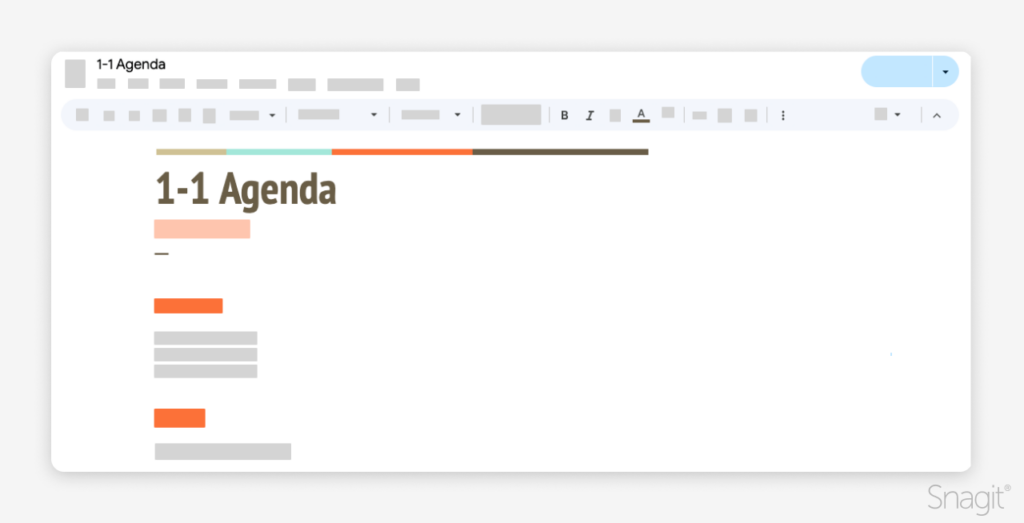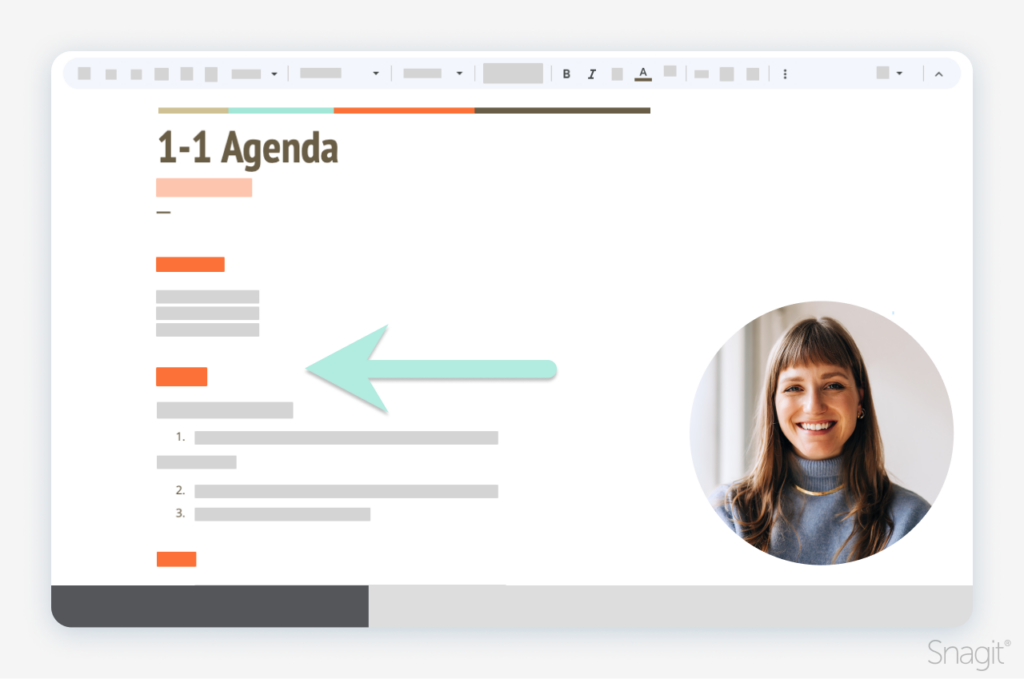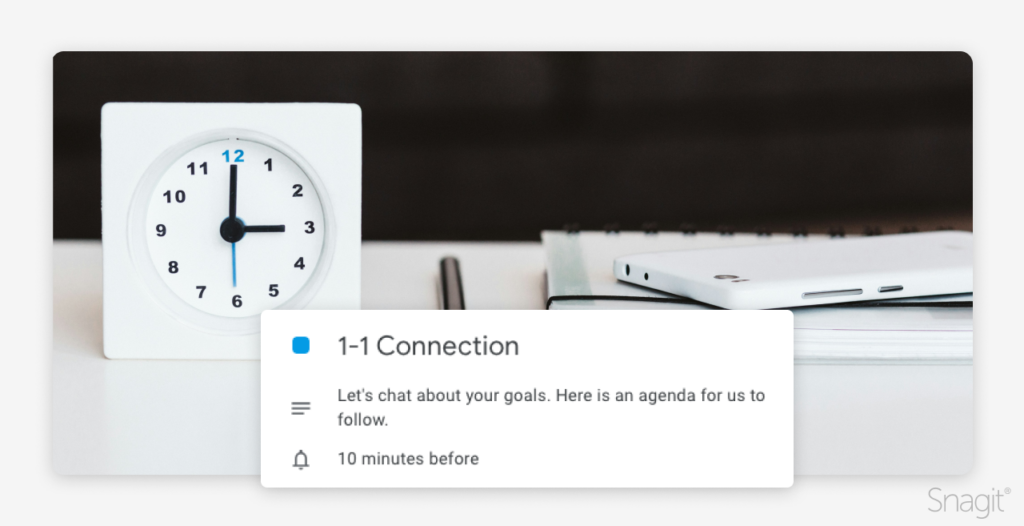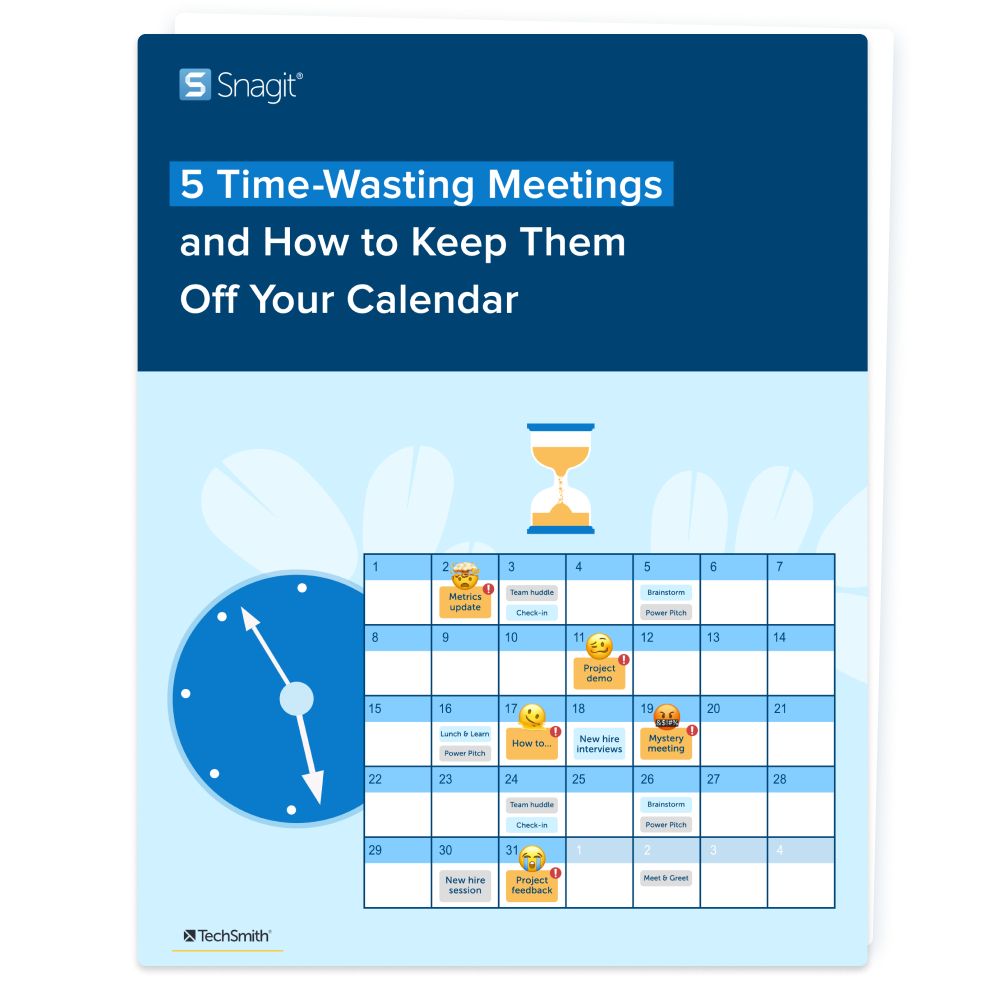One-on-one meetings are vital for building strong working relationships, providing feedback, and discussing career development particularly if it’s a connection with your direct manager or report. If you’re not feeling like you are leaving one-on-ones, especially with your direct manager, with a lot of value then it’s time to revise your approach.
Adopting these tips will support a more structured approach, that will leave some space for fluidity of conversation while ensuring you get all of the practical bases covered you need to continue successfully within your role before your next connection.
To optimize your one-on-one time and experience, consider the structure of your one-on-one, set an agenda, and be deliberate about the time allocated and the setting for your one-on-one.
This doesn’t mean you have to ditch the personal nature of your one-on-one completely either – this can be a great place for you to get to know your manager, employee, or colleague even better so that you can foster an even healthier working relationship and support one another’s career growth.
These tips will help you turn your one-on-ones from a chore into a chance to connect, collaborate, and maybe even have a little fun.
Create and maintain a running agenda
Effective agenda templates help ensure these meetings are productive and focused. The most effective one-on-one meeting agenda templates share certain qualities: they are structured, flexible, promote open communication, and help both parties prepare.

Here are some of the best one-on-one meeting agenda templates and why they stand out:
The 3 P’s: progress, priorities, problems
Why it’s effective
Structured yet flexible: This template focuses on key areas that matter in any role, making it adaptable for various industries.
Balanced: Encourages discussion on both achievements and challenges, giving a comprehensive overview of performance and upcoming work.
Actionable: Each section can lead to clear next steps, ensuring accountability.
Template example
Progress: What have you accomplished since our last meeting?
Priorities: What are your main goals for the upcoming week/month?
Problems: Are there any challenges you’re facing?
Feedback-centered agenda
Why it’s effective
Focused on growth: This template prioritizes feedback, fostering continuous improvement and development.
Open dialogue: It encourages both the employee and the manager to share feedback, creating a two-way communication channel.
Employee empowerment: It allows the employee to bring up topics they want feedback on, promoting engagement.
Template example
Wins and what went well: What recent achievements should we celebrate?
Challenges: What obstacles have you faced and how can I support you?
Feedback: What feedback do you have for me? Here’s some feedback I have prepared for you.
Growth: What skills or areas would you like to develop further?
Check-in & well-being agenda
Why it’s effective
Holistic approach: It addresses not only work progress but also the employee’s well-being, mental health, and job satisfaction.
Engagement and retention: Showing care for employees’ well-being boosts engagement and reduces turnover.
Builds trust: Regular check-ins on well-being build a culture of trust and support.
Template example
Well-being: How are you feeling overall—both at work and outside of work?
Workload: How manageable is your current workload?
Support: Is there anything you need from me or the team to help balance your workload or stress levels?
Personal/professional development: Are there any personal development goals you’d like to focus on?
Open discussion agenda
Why it’s effective
Flexibility: Provides more freedom for the employee to bring up whatever is on their mind, fostering an open-ended discussion.
Adaptable: Can be tailored based on the priorities of the moment, making it suitable for dynamic work environments.
Engagement-driven: Encourages employees to take ownership of the conversation.
Template example
Topics from the employee: What would you like to discuss today?
Topics from the manager: Items they see as valuable to cover
Next steps: What actions should we take before the next one-on-one?
Why these templates stand out
Clear structure: Each template is designed to keep the meeting focused and efficient, ensuring that important topics are covered without going off track.
Balance of work and personal development: The best templates cover immediate work-related matters and long-term career growth.
Customization: These agendas can be tailored to fit different needs, whether focusing on feedback, well-being, or performance.
Engagement: Employees feel more involved and valued when their input is actively sought and prioritized, fostering a stronger manager-employee relationship.
When you sit down for your one-on-one, start by ranking the items on your agenda from most to least important. This way, if time runs short, you can prioritize the most critical topics. As you discuss each item, cross it off the list and document any decisions or action items. This keeps everyone on the same page and ensures you can refer back to the meeting notes later.
Use your time wisely: Flip the meeting
Synchronous time, whether in-person or remote via a video call, is precious. This should not be a place reserved for status updates that don’t require that one-on-one synchronous time.
This is where you should feel most comfortable asking open-ended questions, having discussions, brainstorming, and debating the best path forward in a safe environment. It’s a space to really understand the perspective of your manager or colleague so that you can go forth and be enabled to do your best work.
To ensure you get to the heart of this as quickly as possible – if you have a status update to provide or background information that’s going to lay the groundwork for a lively discussion with your team member, then you should flip the meeting by sending a personalized video update beforehand.

Sending out a video or presentation beforehand allows the person you’re meeting with to lean into active listening, really digesting the information provided prior to your connection. Preparing them to discuss, not just digest during your valuable time together.
Plus, it’s a game-changer for different learning styles. Some people love to think on their feet, while others need time to process and gather their talking points. Flipping the meeting ensures everyone gets a chance to shine. Check out this quick 2-minute video for how to flip a meeting.
Video messages > meetings
Record your screen and camera with Snagit for quick updates and feedback.
Learn More
Keep one-on-one meetings short (30 minutes) for maximum effectiveness
Although some meetings are designed for more depth at certain times of the year, such as performance management or performance review conversations, recurring meetings can be shorter while still being a place to receive feedback on an ongoing basis.
One-on-one meetings are an essential part of employee development and communication in any organization. However, keeping these meetings short—preferably around 30 minutes—can make them more effective than longer sessions. Here’s why a 30-minute one-on-one is often more impactful than a full hour.

Increased focus and efficiency
When meetings are capped at 30 minutes, both the manager and the employee are encouraged to be more intentional about their time. A shorter meeting requires participants to prioritize key issues, rather than digress into less important topics.
Why this works
Having a tight schedule forces you to stick to core subjects like progress updates, challenges, and next steps. It discourages unnecessary tangents and keeps the conversation results-oriented.
Both parties are likely to prepare better, ensuring that the limited time is used effectively, leading to a more productive meeting.
The need to make decisions or resolve issues within a limited time promotes clarity and quick action, which helps in keeping projects moving forward.
Prevents meeting fatigue
Longer meetings often suffer from diminishing returns, as participants become mentally fatigued. After about 30 minutes, attention levels tend to drop, reducing engagement and effectiveness. Shorter meetings help maintain high energy and focus throughout the conversation.
Why this works
A 30-minute meeting keeps participants fresh and engaged, making for a more dynamic conversation.
With less time, there’s less opportunity for the discussion to drift into unrelated or lower-priority topics, which often happens in hour-long meetings.
Supports more frequent check-ins
If one-on-one meetings are kept short, it’s easier to schedule them more frequently—whether weekly or bi-weekly. This allows for ongoing communication and quick course corrections, rather than waiting for larger issues to pile up over time.
Why this works
More frequent, shorter meetings provide an opportunity for real-time feedback, addressing issues before they escalate.
Frequent touchpoints keep both the manager and employee aligned on goals, progress, and priorities without the need for extended infrequent meetings.
Boosts productivity across the team
By keeping one-on-ones to 30 minutes, managers have more time to focus on other high-priority tasks. Similarly, employees appreciate that their time is respected, allowing them to get back to their work without losing momentum.
Why this works
Short meetings fit more easily into busy schedules, making it easier for both parties to balance meetings with their daily responsibilities.
For managers with larger teams, shorter meetings allow them to meet more frequently with individual team members without sacrificing time for other tasks.
Encourages concise communication
Shorter one-on-one meetings promote clearer and more concise communication. Both parties are more likely to get to the point and avoid over-explaining or indulging in unnecessary details.
Why this works
Participants are more likely to leave the meeting with clear, actionable takeaways because the conversation is focused on critical matters.
A concise meeting means follow-ups and next steps are more likely to be remembered and acted upon, creating a stronger culture of accountability.
Fits flexibility into busy schedules
In today’s fast-paced work environment, both managers and employees are juggling numerous responsibilities. A 30-minute one-on-one is easier to slot into a busy day and less likely to be canceled or rescheduled due to time conflicts.
Why this works
When meetings are shorter, it helps ensure that both managers and employees have adequate time for other meetings, deep work, and personal tasks.
hort meetings are easier to schedule, making it more likely that they happen consistently, improving overall communication and connection.
Conclusion
Shorter, 30-minute one-on-one meetings are not just a time-saving strategy—they enhance focus, prevent fatigue, and create an environment for more frequent, effective check-ins. By encouraging concise communication and reducing time-wasting tendencies, they help ensure meetings are productive and actionable, benefiting both employees and managers.
For those aiming to optimize their one-on-one meetings, shorter is often better, keeping the conversation sharp, focused, and productive.
Host the occasional in-person meeting
In today’s remote-first world, video calls and messaging platforms have become the default modes of communication. While these virtual meetings are efficient, there are several reasons why holding in-person one-on-ones can still be crucial—particularly in remote or hybrid work environments.

Build stronger relationships
In-person meetings provide a unique opportunity to build deeper, more authentic connections. Human interactions are richer when they take place face-to-face, allowing for more natural communication and rapport-building.
Why this matters
In-person conversations allow for more nuanced understanding of body language, facial expressions, and tone of voice, which are often lost in video calls.
Meeting in person fosters a sense of trust and empathy that is difficult to replicate virtually. This is especially important for remote employees who may feel disconnected from their managers or teams.
Encourage open dialogue
In-person settings create an environment where employees often feel more comfortable expressing concerns, giving feedback, or discussing personal matters. The physical proximity and shared space encourage more open, honest dialogue.
Why this matters
Video calls can feel rigid, with a structured agenda, while an in-person meeting, especially over coffee or in a relaxed setting, can facilitate more organic and casual conversations.
In-person interactions reduce the perceived distance between employees and managers, making employees feel safer sharing their thoughts and feelings.
Enhanced focus and engagement
Remote meetings can suffer from distractions, whether it’s email notifications, technical issues, or household interruptions. In-person one-on-ones eliminate these virtual barriers, allowing both parties to be fully present in the moment.
Why this matters
Being in the same room fosters more focused engagement, leading to a higher-quality conversation. Without screens in the way, you can maintain eye contact and truly listen to each other.
When both parties are fully engaged, problem-solving becomes more collaborative and effective, leading to quicker resolutions.
Fostering company culture
In-person meetings reinforce the cultural connection between employees and the company. Remote workers, especially those who rarely visit the office, may feel detached from the broader organizational culture. Meeting face-to-face helps re-establish that bond.
Why this matters
An in-person meeting can help employees feel more connected to the company’s values, mission, and team dynamics, which is harder to achieve through virtual interactions.
Remote employees often miss out on casual office interactions. In-person meetings can help recreate some of that camaraderie and belonging.
Handle sensitive conversations
Sensitive topics such as performance reviews, personal challenges, or difficult feedback are best handled face-to-face. In-person meetings allow managers to convey empathy and understanding more effectively during challenging discussions.
Why this matters
Delivering difficult news or feedback in person allows for more emotional sensitivity, as both parties can read and respond to each other’s body language and emotions more accurately.
When an employee receives feedback or discusses a personal issue, the presence of their manager in person can offer a sense of comfort and support that a virtual meeting may not.
Create space for brainstorming and creativity
In-person one-on-ones provide a unique space for brainstorming and problem-solving, which can feel more fluid in person than online. Sometimes, the energy of being in the same room sparks creativity that a virtual meeting simply can’t replicate.
Why this matters
In-person discussions often lead to more spontaneous and creative exchanges, which can be harder to achieve in structured virtual meetings.
Being physically together allows for activities like whiteboarding or sketching out ideas in real time, which can speed up creative problem-solving.
Re-establish human connection in a remote-first world
In a remote work environment, employees may go long stretches without interacting with colleagues in person. Occasional face-to-face one-on-one meetings offer an essential opportunity to reconnect on a human level.
Why this matters
Remote work can lead to feelings of isolation. An in-person meeting reminds employees that they are part of a team and that their manager is accessible and approachable.
Meeting in person can reinvigorate employees, renewing their sense of purpose and connection to their work.
Conclusion
While remote work has its advantages, the value of in-person one-on-ones cannot be underestimated. Whether it’s building stronger relationships, encouraging open dialogue, or handling sensitive conversations, there are certain aspects of human connection that can only be fully realized when meeting face-to-face.
In-person one-on-ones create a deeper, more meaningful experience that strengthens trust, enhances communication, and ultimately leads to better employee engagement and satisfaction. Incorporating them into a primarily remote work environment is a powerful way to maintain human connection and foster greater trust.
People work best for people they know, like, trust, and respect. Take the time to create a personal connection with your manager or direct reports. Whether in person or remote – take a few minutes of each one-on-one to discuss non-work-related topics. Here are some conversation starters for the workplace from BetterUp to help break the ice:
- What’s your favorite part of your job?
- What was your first job?
- Do you have any side hustles or projects?
- When you work remotely, do you work in a cafe or from home?
- What’s one thing you’re passionate about in your career?
- If you could describe your ideal work-life balance, what would it look like?
- What’s one thing that motivates you at work?
- What’s something valuable you’ve learned during your career?
- Are there any upcoming projects you’re excited about?
- Did you ever think about trying a different career before this one?
- What made you want to work for [company]?
- Did you go to school to become a [job role]?
- Do you have any tips for time management?
By following these tips, you can make your one-on-one meetings more effective and enjoyable for everyone involved. Remember, the goal is to build strong relationships and achieve your goals together.
Now that you’re a rockstar at one-on-ones, want to improve more of your meetings? Download our free guide below.
Stop wasting time in pointless meetings
See how small changes to the way you share information can help you reclaim your time at work.
Get the Guide



Share